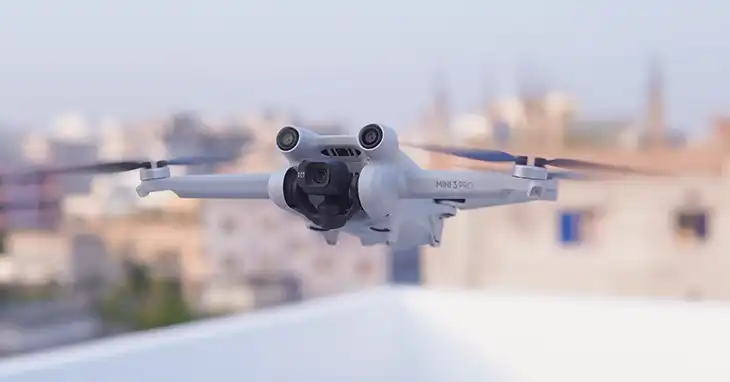The DJI Mini 3 Pro is a compact and lightweight drone that has captured the hearts of aerial photographers and videographers worldwide. Its portable design and impressive camera capabilities make it a popular choice for capturing stunning aerial footage. However, one of the most frequently asked questions by Mini 3 Pro pilots is, “How high can this little powerhouse fly?”
While in EU regions, the maximum legal altitude is 120 meters, in other regions worldwide, you can fly your DJI Mini 3 Pro up to 500 meters high. However, that’s not the maximum service ceiling these drones can operate, which we’ll explore later on in this article. Let’s begin.

What’s the Legal Flight Altitude for the DJI Mini 3 Pro
Drone regulations vary across different regions and countries, and it’s essential to familiarize yourself with the local laws and guidelines. The table below summarizes the legal flight altitude limits for the DJI Mini 3 Pro in various regions:
| Region | Legal Maximum Altitude (from ground) | Notes |
| Global (except EU) | 500 meters (1,640 feet) | Set by DJI for safety reasons. |
| European Union (EU) | 120 meters (394 feet) (from January 1, 2024) | Applies to all drones under 250g (C0 class). |
| United States (FAA) | 400 feet (122 meters) | For recreational flyers. Additional rules apply for commercial operators. |
| Canada | 122 meters (400 feet) | Specific rules may vary by province or territory. |
| Australia | 120 meters (400 feet) | Exceptions may apply with proper approvals. |
It’s crucial to note that violating these legal flight altitude regulations can result in significant fines or even legal consequences. Always prioritize safety and compliance with local drone laws.
Additionally, some regions or locations may require special permits or exemptions for flying at higher altitudes. Be sure to research and obtain any necessary permits before attempting to fly your DJI Mini 3 Pro above the legal limits.
What’s the Maximum Service Ceiling for DJI Mini 3 Pro
According to DJI’s specifications, the Mini 3 Pro has a maximum service ceiling of:
- 4000 meters (13,123 feet) above sea level with the standard battery
- 3000 meters (9,843 feet) above sea level with the Plus battery
It’s important to understand the difference between the service ceiling and the practical flight altitude. The service ceiling is the maximum altitude at which the drone can theoretically operate, but various environmental factors and battery life can significantly impact the achievable height in real-world conditions.
When compared to other DJI drone models, the Mini 3 Pro’s maximum service ceiling is relatively modest. For example, the DJI Air 2S can reach a service ceiling of 6000 meters (19,685 feet), while the Mavic 3 can soar up to 6000 meters (19,685 feet) above sea level.
What Affects Flight Altitude
Several environmental factors can influence the DJI Mini 3 Pro’s ability to reach its maximum service ceiling or practical flight altitude. These include:
- Wind Speed: Strong winds can significantly impact the drone’s flight performance and stability, making it more challenging to maintain altitude or ascend further.
- Temperature: Extreme temperatures, both hot and cold, can affect battery performance and overall flight time, indirectly limiting the achievable altitude.
- Air Pressure: Changes in air pressure at higher altitudes can impact the drone’s lift and maneuverability, potentially reducing its maximum achievable height.
The chart below illustrates the relationship between wind speed and the recommended maximum altitude for the safe operation of the DJI Mini 3 Pro:
| Wind Speed (mph) | Recommended Maximum Altitude (meters) |
| 0-10 | 500 |
| 11-15 | 400 |
| 16-20 | 300 |
| 21-25 | 200 |
| 26+ | Avoid flying |
It’s essential to consider these environmental factors and adjust your flight plan accordingly to ensure a safe and successful mission.
Maximizing Flight Time at High Altitudes
While the DJI Mini 3 Pro has its limitations, there are several tips and techniques you can employ to maximize your flight time and achieve higher practical altitudes:
- Flight Modes: Use flight modes that consume less power, such as Cine mode, which is designed for smooth and efficient camera movements.
- Flight Path Optimization: Plan your flight path carefully to avoid unnecessary maneuvers and minimize energy consumption. Consider using waypoint flight modes or pre-programmed routes.
- Landing Pad: Using a landing pad can help ensure smoother landings, reducing the risk of damage and conserving battery life for longer flights.
- Battery Management: In cold weather conditions, consider pre-heating or insulating your batteries to maintain optimal performance and extend flight time.
Final Words
The DJI Mini 3 Pro is a remarkable drone that offers a unique combination of portability and aerial photography capabilities. However, understanding its maximum service ceiling, legal flight altitude restrictions, and the various factors that can impact its performance at high altitudes is essential for safe and responsible operation.
Remember to always prioritize safety, follow local drone regulations, and fly within the drone’s capabilities and legal restrictions. Consult the DJI Mini 3 Pro user manual, safety guidelines, and seek advice from experienced pilots or DJI support if you have any doubts or questions.
